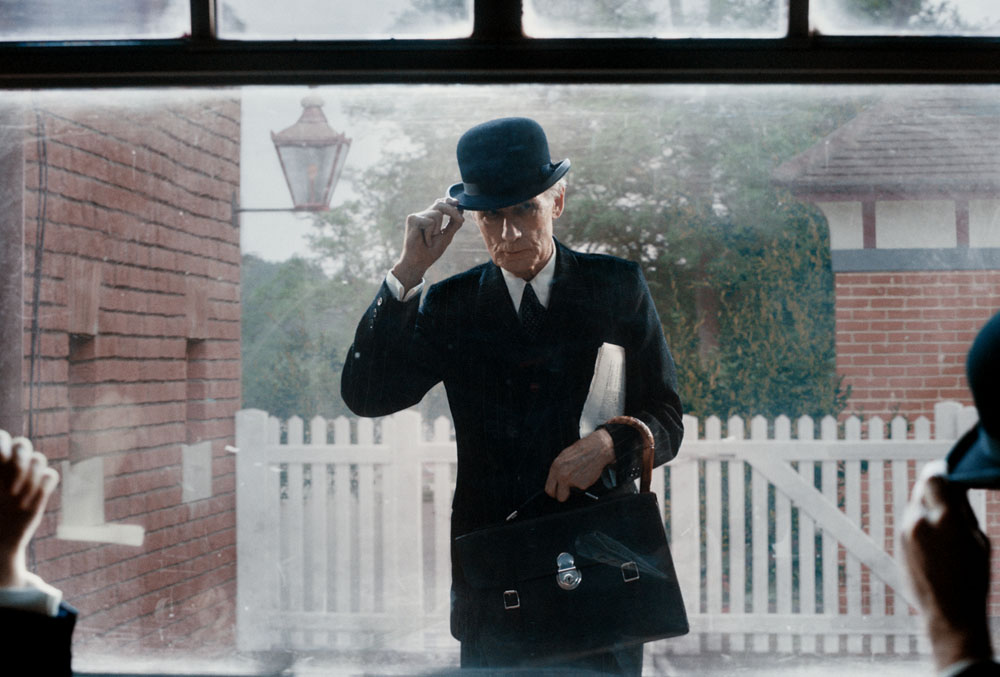Kazuo Ishiguro has had few regrets over the course of an illustrious career, but there could’ve been one had he resisted the temptation to pitch Bill Nighy an idea he had been nursing for some time. The Nobel Prize winning author and his wife found themselves sharing a cab with the actor and if Ishiguro had been intimidated by the thought of coming off like any number of starstruck would-be producers trying to get Nighy to commit to making a movie with them, there was the additional potential for embarrassment when his suggestion involved remaking a classic so revered in Akira Kurosawa’s “Ikiru” that even attempting it might seem like a fool’s errand. Still, if anyone was to understand the story of someone overcoming any self-consciousness to seize the moment — though in far better health than the cancer-ridden Mr. Watanabe (Takashi Shimura) of the original — Ishiguro could certainly identify as he pitched the film to Nighy.
“[Then] I just got sucked into this [myself],” Ishiguro laughs now, having planned to simply plant the seed of the idea in Nighy’s mind, as well as the producer Stephen Woolley, whose dinner party they were leaving, and wait to see the fruits of their labor.
Instead, Ishiguro was pressed into duty when obtaining the rights to “Ikiru” from the Kurosawa estate became far easier with the tantalizing possibility that the “Remains of the Day” and “Never Let Me Go” might adapt upon learning he was the one who had the notion in the first place, and although he had never been involved in a film that wasn’t based on one of his own works, the writer had been carrying around images in his head of what they story might look like in post-war England ever since seeing Kurosawa’s masterpiece when he was 12. Even then the tale of a mid-level pensioner who takes his destiny into his own hands after learning he won’t be around much longer resonated with Ishiguro, who could see people around him experiencing a similar stasis as they busied themselves in service of the larger society without considering what they owed to themselves after enduring such trauma and destruction.
These seemingly parallel senses of purpose were always seen as one and the same in “Ikiru” when Mr. Watanabe in “Ikiru” set his sights on clearing the red tape for a park that could benefit the local community, a redemptive act for being trapped in the bureaucratic system for so long that there is no one better to know the ins and outs of it, but in Ishiguro’s incandescent new take on the tale in “Living,” made even more radiant by the direction of Oliver Hermanus, it induces a full-on spiritual rejuvenation as Mr. Williams (Nighy) disappears from work in the wake of his diagnosis and finds his death sentence removes any fears he had of straying from the company line, standing out in a place ruled by conformity with his younger colleagues such as Peter (Alex Sharp) and Margaret (Aimee Lou Wood) taking notice. Bursting with color as the film glimpses at people going about their days in Piccadilly Square like ants at a picnic, Hermanus brings out what’s long resided inside of Mr. Williams as the joy to be found in the world around him emerges vividly and and gives the space to a truly marvelous cast led by Nighy to magnificently summon long-suppressed emotions to the surface.
After a celebrated festival run that began this past January at Sundance and ends the year with Nighy a leading contender for an Oscar, “Living” begins its theatrical run this week and keeping in line with the evident generosity of spirit in their work, Ishiguro and Hermanus graciously spoke of their collaboration, their inspirations and finding the song – and the scene – that would become the emotional centerpiece for the film.
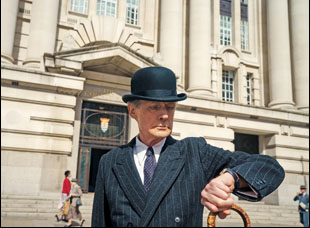 Oliver, when we last spoke for “Moffie,” you said you were about to do a movie in England and I had no idea what you were walking into. Given what an undertaking this was, did you?
Oliver, when we last spoke for “Moffie,” you said you were about to do a movie in England and I had no idea what you were walking into. Given what an undertaking this was, did you?
Oliver Hermanus: Well, the last time you and I spoke, I was exactly in the same position I am now. I was weeks away from shooting “Living” and I remember very clearly it was Easter. It was the only day I could do press, and I was definitely excited by the people making it and wanted to see what they were up to. It felt wrong, but it felt right – not wrong because of them, but just wrong because of the idea of remaking a Kurosawa film, which I’m not sure many filmmakers would. All the filmmakers I spoke to [beforehand] when I was saying, “Oh, I’m really thinking of doing this movie in England,” I’d always wait a minute to say, “It’s a remake of a Kurosawa.” And that’s when all of the friends would start screaming and running around going, “Are you nuts?” So it had that effect in my life for a while. [laughs]
Kazuo Ishiguro: For a long time, when it was just myself and Stephen Woolley, the producer developing the movie, we talked a lot about what director we wanted and for this particular project because it was a period British subject and setting, we made a decision that we didn’t want a British director. We didn’t want this to look like a lot of other British period films that have been coming out recently and we thought an outsider, perhaps somebody that wouldn’t be so obsessed with the British class system, would have a different outlook. They’d be able to pull out what was universal to everybody around the world in that situation, so we wouldn’t look at British directors, even though there are some very good ones, and when Stephen Woolley came across “Moffie” at a festival and said, “Take a look at this. Still in his thirties, but just look at this,” and I thought here’s a monster talent. We’d be lucky to get him on the way up.
Still, Olivier, was that an intimidating situation to walk into – not just as an adaptation of “Ikiru” but having such a formidible collaborator as Ishiguro?
Oliver Hermanus: Ishiguro is a very rare kind of person because his intelligence and his intellect is very seriously unmatched, but when somebody’s that in command of things and that talented and that smart, I don’t think there’s any situation that Ishiguro walks into where he doesn’t feel like he can hold his own and that it makes him an incredibly generous person. He’s able to spend time with you and initiate you into things and inspire you with a real sense of patience about it. And he really gave me a lot of time because I interrogated every bit of the screenplay. I was always asking for rewrites, always asking for changes and fixing this. I was relentless. In fact, he refers to me as having a savage approach to screenwriting where I seemed to hack away everything just to then put it back together the way it was. And I don’t think that every relationship [with a writer] is like that. He afforded me a lot of his time and a lot of his patience, which I’m very grateful for.
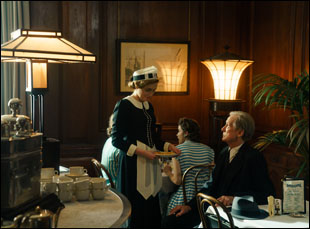 I’ve heard it also might’ve involved movie playlists. What did you watch before filming this?
I’ve heard it also might’ve involved movie playlists. What did you watch before filming this?
Oliver Hermanus: He was actually sending me hard copies of DVDs during the pandemic, which was interesting. It took them months to get to me because I was living in a very abject part of South Africa. But he is a real cinephile, and one of the very rare things that ever happens where you talk to Ishiguro about a movie and he says, “I’ve not seen that.” It stupefies me because I imagine that he’s seen absolutely everything, so he is a wealth of knowledge about film. He’s a passionate film watcher.
Kazuo Ishiguro: Oliver has a background in photography, so he immersed himself in photography of Britain of that time, particularly London, but I suggested the British Hitchcocks like “The Man Who Knew Too Much” and “The Lady Vanishes,” [which] isn’t set in Britain, but the characters on that train are so English and come from a time before the [they] lost their confidence about a certain kind of British manner. They were still very cocky, believing that they were at the center of the world, and I thought that’s a kind of manner that drains out of British movies in the 1950s. [I also suggested] the Powell and Pressburger movies, particularly “Colonel Blimp” and “I Know Where I’m Going,” and then some movies made directly after the war like Carol Reed’s “A Fallen Idol” and a director that I think is quite underestimated, Basil Dearden’s “The Blue Lamp” and “Pool of London.” I thought they captured London after the war very well.
Oliver [also has] said quite important for him were my recommendations of films that didn’t seem to be particularly relevant to our project, but I asked him to take a look at two movies that were shot in a German expressionist style although they were filming English guys in dinner jackets — “Rome Express,” [which] although it’s directed by Walter Ford, the cinematographer was Günther Krampf, who was Pabst’s cinematographer on things like “Pandora’s Box” and fled Nazi Germany to end up in Britain. [He also] lensed “Death at a Broadcast,” which I think is a beautiful film. It has a really creaky plot, but you don’t associate British characters and clothes and decor being shot in this kind of [German] expressionist style and I thought that was a really interesting combination and [Oliver] told me that was quite helpful to have a look at this way of shooting Englishness and English people.
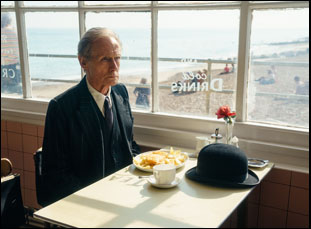 One of the most immediately striking elements of the film is how it employs color – there’s a real vibrancy from the start that only becomes more lively. Was that in mind from the start?
One of the most immediately striking elements of the film is how it employs color – there’s a real vibrancy from the start that only becomes more lively. Was that in mind from the start?
Oliver Hermanus: The design of this movie was always meant to be incredibly muted and I wanted to grow into life in a controlled manner. I’ve seen too many films where this idea of blooming becomes very [over the top] and every aspect of the design, [from] its costume and production and lighting and camerawork, all suddenly all explode. I think that’s just slightly unconsidered, so I was far more controlled about it and I allowed for the costume to be the one that really opens up with Aimee [Lou Wood’s character] — she starts to wear a lot more color, but then with everything else, it’s very controlled. In fact, I liked the fact at the end of the film when we go back to black and white where it’s very much a black space with white snow. There was a unification for me [there] and never really allowed the design to get colorful.
One remarkable scene that you’re able to pull off wordlessly because of the intensity of the colors and the composition is when Mr. Williams comes home following his cancer diagnosis, surrounded by family photos that inspire flashbacks that burst like polaroids in his mind as he’s weighing whether to pass along the news to his son. How did that sequence come together?
Kazuo Ishiguro: That scene is quite faithful to the original Kurosawa sequence. Generally, I wanted to dial down the surface emotions of the original movie, which seems like an odd thing to say about anything Japanese because the emotions are [usually] below the surface. But I always thought as much as Kurosawa’s film had a profound influence on me, what would it have been like if the main actor hadn’t shown his suffering and his melancholy and his fear on his face so clearly and not only on his face, but his posture and the way he walked. What if he had been more like Chishū Ryū, the actor who plays the father in “Tokyo Story”? So the idea of casting Bill Nighy is like changing Ryu for the guy. [laughs]
And that scene where he gets back to the house after the diagnosis, I thought it would be much more stoic. He wouldn’t start crying or burying himself under his duvet, as moving as that is, In our English incarnation, you’ll feel that sorrow because it’s a complicated sorrow. He’s remembering how close he was to his son when his son was a child and through the growing years and he can suddenly measure the distance between them at that moment when he wants to tell him something desperate and he can’t. But the beautiful sequence that Kurosawa created of those memories, just coming one after the other, I thought was so beautifully done, I didn’t see any reason to deviate from that very much.
Oliver Hermanus: We were meant to do it [so that] Bill’s meant to be present in the memories, so you’d see him watching his son [in a flashback] and you see him in the car, but I never thought that was right because that would be too complicated with de-aging, so then I said, “Ishiguro, what if I just have him looking into the camera and play it as a sound experience and you go into slightly more lucid memory?” And that’s what we agreed on. I shot the other scenes first [of the flashbacks views through Williams’ perspective] and I had the audio with me on set and I had a speaker next to Bill and I would just cue it [as he would look at pictures around the house]. I was able to control it from my monitor. I would have him looking away from the camera and then looking into the camera and I would play [the sound] at different times, so he wouldn’t know when it was coming and there was an element of surprise for him.
It’s one of the hardest things I think any actor can do, which is to act into the lens of a camera or a mirror because they’re seeing themselves in a reflective surface and play the character, and I remember thinking how amazing that Bill could do this, where he can turn into the lens, which is right in front of him and he’s listening to what I’m playing to him, which is the sound of crickets or the sound of his son calling his name, and he’s just having this audio experience, but he can see his reflection in the lens. It was just such a joy to watch him do it.
Kazuo Ishiguro: The thing I did want to change in my script was how he discovers he actually has terminal cancer. In the Kurosawa film, the character is chased around the clinic by some kind of weird man who is coming out with the symptoms of stomach cancer, so I thought let’s bring it down to one word. The doctor wouldn’t even say, “You’ve got terminal cancer.” He’d just say, “It’s very difficult, this” and I thought we’ll reduce Williams’ reaction to a single word, “Quite.” And I thought that was a very English way of doing it. [laughs]
Did the idea of the train station come naturally as part of the structure of this? The commute to work plays such a large part in getting to understand the cloistered, career-minded life that Mr. Williams has had?
Kazuo Ishiguro: It came quite naturally in that from the age of 11 to the age of 18, I had to travel to my school by train. I was living in a place called Guildford, which is 30 minutes south of London, and that same train line was the commuter line for those office workers who traveled to London and in those days — the 1960s to the early 1970s — those commuters looked exactly like those guys in “Living.” They had bowler hats and these umbrellas and a certain frosty way of greeting each other in the mornings. You could see the office hierarchy represented on the station platform. Some guys were going to first class carriages and others were going to the standard ones and they would tip their hats to their bosses and I would overhear their conversations. This would go on for seven years for me, and there was a feeling not just for me but amongst my fellow school boys who traveled in that at a certain point, we would just become those guys. Part of the reason “Ikiru” meant a lot to me was because I suppose a part of me thought there was a high chance I’d be working in an office environment like those guys, so when I thought about how to adapt this to an English setting, it was very natural that I would just go back to those days when I used to travel in with these kind of “English gentlemen,” as we like to call them.
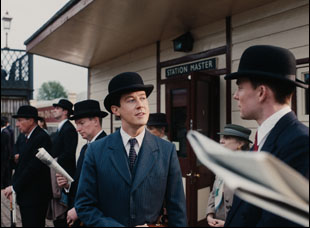 There is so much packed into the film in terms of establishing shots and it surely plays bigger than you had the time for. What was it like protecting the performances from being rushed?
There is so much packed into the film in terms of establishing shots and it surely plays bigger than you had the time for. What was it like protecting the performances from being rushed?
Oliver Hermanus: Yeah, always a challenge and always a fight against time. With this cast, it was never like I was doing takes with the cast trying to warm them up and get them to a good place. You generally started from a good place with them and you were just going other places with them and you were getting a lot more out of them, particularly with Alex Sharp. Alex Sharp could do everything 90 different ways and you’d think [one take] was the only way to do it, and then he would do a totally different way and you’d go, “Oh God, I think I like that more.” And with Alex, I would find that people would be like, “You really should be moving on now. You’ve played with Alex enough. Can we shoot somebody else?” [laughs] He was just an extraordinary actor, extraordinary skill.
What was it like setting the stage for Bill to sing that ballad?
Oliver Hermanus: It was one of those days where everyone’s a little bit nervous because you don’t want to miss the moment and Bill is often nervous about rehearsing something like that because he’s afraid that he will do his favorite version as his first version, but sometimes you’ve got to rehearse it for the background and for the camera, so it’s this little dance that you have to do where I don’t want him to sing it until we have a lot of the elements ready to go. But what I actually did was [have him do it] and he thought that I hadn’t shot it, and later in the day he was like, “I knew we should’ve shot the rehearsal. The rehearsal was the best.” I was like, “Well, of course I shot the rehearsal. I just didn’t tell you because you just would’ve freaked out a little bit if you knew that it was being shot.” So that was one of those days where it all comes together because you are working with an actor you now know how they think and how they work and you’re also working around them getting it right. It’s very rare when you shoot a scene on a set and for the people on the set, it feels like the finished scene because they’re recognizing the emotion of the scene although they’re seeing it in pieces.
Bill’s said that he didn’t know the song was a personal favorite of Kazuo’s wife until recently. What led to you picking it?
Kazuo Ishiguro: Yeah, the song’s called “Rowan Tree,” and I don’t really know a record of it. It’s not a song that really was a hit, but it’s a song my wife and I have have just sung [as] amateur musicians, playing guitars and she learned it from her grandmother. I associate it with Scotland and my wife and although she is completely fit, alive and very lively, Mr. Williams has lost his wife and in the original Kurosawa film, the song that he sings at equivalent points actually refers directly to the themes of the film. The words start, “Life is short but…” So I thought in our film, we shouldn’t have lyrics that refer directly to the situation or his predicament, but I also wanted to remind the audience that he had a wife and he’s still in mourning. Somewhere along the way, he lost something when he lost his wife, and when he sang, the song should be something that told you this aspect of his story. [SPOILERS AHEAD] And in that final scene when he’s on the swing, he’s not just happier singing because he’s fulfilled his ambition in creating this playground, but his memory has come back to him of his dead wife and wants to share it with her. That’s why he sings that song. It’s a song I love because it has a beautiful melody and I thought it was one Bill could sing well, but also for me, as a screenwriter, it was a really important way of introducing that dimension about bereavement and [how] he comes out of his bereavement at the end [when] the second time he sings it, he’s about to join his wife. [SPOILERS END]
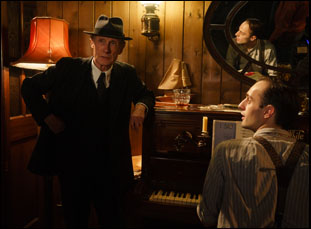 What was it like watching this together for the first time?
What was it like watching this together for the first time?
Oliver Hermanus: It was really stressful. I actually said to Ishiguro that “Living” wouldn’t be done for me until I sat with him in a cinema. Because he hadn’t seen it in a cinema until we went to Venice, and I said, “I have to sit next to you. You have to see it as I have imagined it with the sound and all of the elements together,” and I remember he was sitting next to me and he was crying and his wife was sitting behind us and she was crying and it was only when we showed the film in Venice that I felt that I had finished making the film. Because it was so important to me that Ishiguro saw it in the way that I had tailored it for him.
Kazuo Ishiguro: And I am very proud of it — I’m almost as proud of this as anything I’ve ever done and that’s not just because I think it’s a beautiful, beautiful movie. It exceeded my expectations, partly because of the pandemic — I spent a lot of time discussing it with Oliver when everything was suspended, and I wasn’t able to be on the set because COVID was still quite a serious issue and we were lucky to shoot at all in that era. But the Kurosawa movie meant so much to me when I was young. That movie influenced both the way I approached life and also the way I write my novels, so in a sense, there’s something coming full circle that I was able to contribute to this new version and I’m hoping people will not just watch our version, but go back to the Kurosawa version as well. That’s the other reason I’m really proud of it, not just because of the incredible performances and the beautiful direction in the movie, but for me personally, it’s something that takes me back to childhood.
“Living” opens on December 23rd in Los Angeles at the Laemmle Royal and New York at the Angelika Film Center and the New Plaza Cinema before expanding in the month ahead. You can find a theater near you here.




